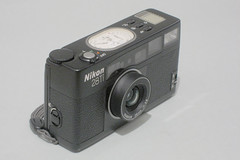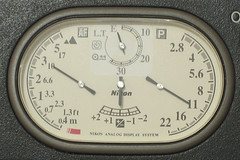Difference between revisions of "Nikon 28Ti"
m (→An analog display?) |
(rearranging) |
||
| Line 3: | Line 3: | ||
''The '''Nikon 28Ti''' was released in 1994. The name refers to the 28mm f/2.8 Nikkor lens and the titanium camera body. The most remarkable feature is the analog display on top. Four needle-style dials indicate focusing distance, aperture, frame number and exposure correction.'' | ''The '''Nikon 28Ti''' was released in 1994. The name refers to the 28mm f/2.8 Nikkor lens and the titanium camera body. The most remarkable feature is the analog display on top. Four needle-style dials indicate focusing distance, aperture, frame number and exposure correction.'' | ||
| + | |||
| + | == Origins == | ||
| + | The '''28Ti''' had been preceded by the 1993 '''35Ti'''. Both are 135 film autofocus cameras of innovative design. [[Nikon]] clearly aimed at producing a easy to transport, high quality camera, albeit with a single focal length. In 1998, Nikon decided to discontinue both cameras. | ||
== An analog display? == | == An analog display? == | ||
| Line 13: | Line 16: | ||
<br> | <br> | ||
<br> | <br> | ||
| − | |||
| − | |||
| − | |||
| − | |||
== Lens and shutter == | == Lens and shutter == | ||
The [[Nikon]] 28Ti has a 28mm [[Nikkor]] lens. Earlier Nikon compacts had had Nikon lenses. All seven elements (in five groups) of the Nikkor are coated using Nikon's ''Integrated Coating''. This results in a lens with good contrast rendition. The shutter and aperture control are placed between the lenses. The shutter is a seven element blade shutter giving an almost circular aperture. The speeds range from 2s to 1/500s. The shutterspeeds cannot be selected manually, but chosen by one of the auto-exposure modes. This selected speed is visible in the viewfinder. | The [[Nikon]] 28Ti has a 28mm [[Nikkor]] lens. Earlier Nikon compacts had had Nikon lenses. All seven elements (in five groups) of the Nikkor are coated using Nikon's ''Integrated Coating''. This results in a lens with good contrast rendition. The shutter and aperture control are placed between the lenses. The shutter is a seven element blade shutter giving an almost circular aperture. The speeds range from 2s to 1/500s. The shutterspeeds cannot be selected manually, but chosen by one of the auto-exposure modes. This selected speed is visible in the viewfinder. | ||
Revision as of 21:34, 19 November 2006
Contents
Introduction
The Nikon 28Ti was released in 1994. The name refers to the 28mm f/2.8 Nikkor lens and the titanium camera body. The most remarkable feature is the analog display on top. Four needle-style dials indicate focusing distance, aperture, frame number and exposure correction.
Origins
The 28Ti had been preceded by the 1993 35Ti. Both are 135 film autofocus cameras of innovative design. Nikon clearly aimed at producing a easy to transport, high quality camera, albeit with a single focal length. In 1998, Nikon decided to discontinue both cameras.
An analog display?
This watch-like display enables the user to operate the camera from the waist. It clearly displays the focusing distance and aperture. two smaller dials show exposure compensation (two stops over or under) and the number of shots taken (framecounter). The latter dial doubles as a self-timer.
Lens and shutter
The Nikon 28Ti has a 28mm Nikkor lens. Earlier Nikon compacts had had Nikon lenses. All seven elements (in five groups) of the Nikkor are coated using Nikon's Integrated Coating. This results in a lens with good contrast rendition. The shutter and aperture control are placed between the lenses. The shutter is a seven element blade shutter giving an almost circular aperture. The speeds range from 2s to 1/500s. The shutterspeeds cannot be selected manually, but chosen by one of the auto-exposure modes. This selected speed is visible in the viewfinder.
Viewfinder information
The viewfinder shows the autofocus dot in the center and three sets of parallax cerrection lines. In the infinity focus mode, the entire frame is used, the other framelines are formedium range (.4 to 1.2m), close (.4 to 10.5m) and panoramic. The bottom of the viewfinder shows the shutterspeed, exposure compensation and a flash indicator.
Images
Links
- an in-depth description of the Nikon 28Ti.
- an officious online manual.





